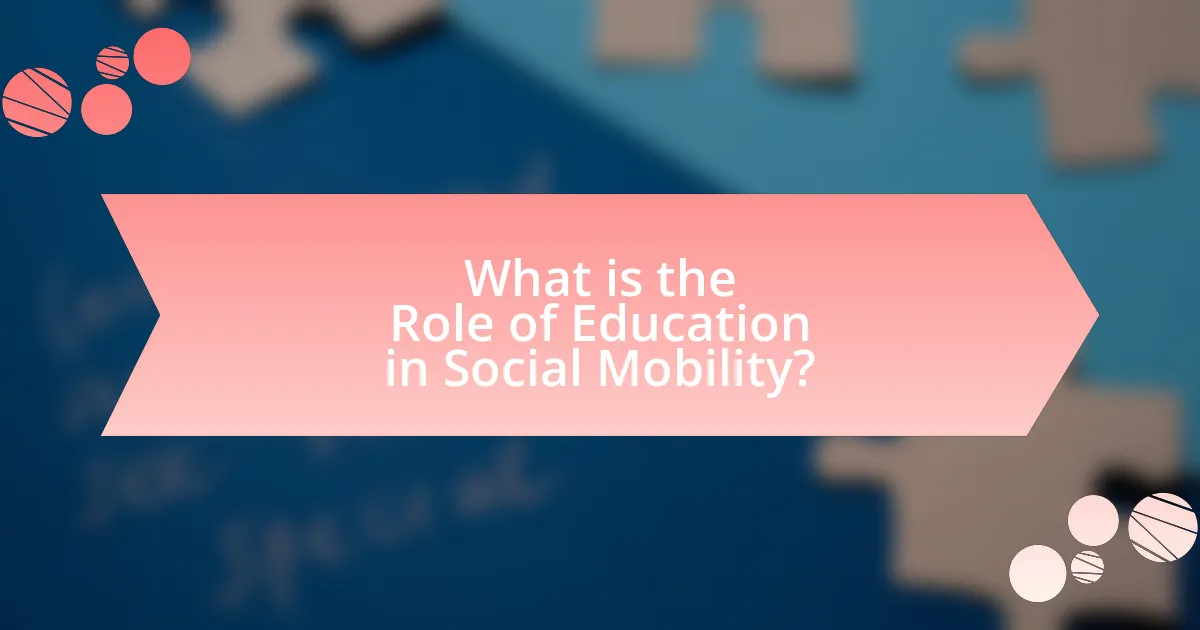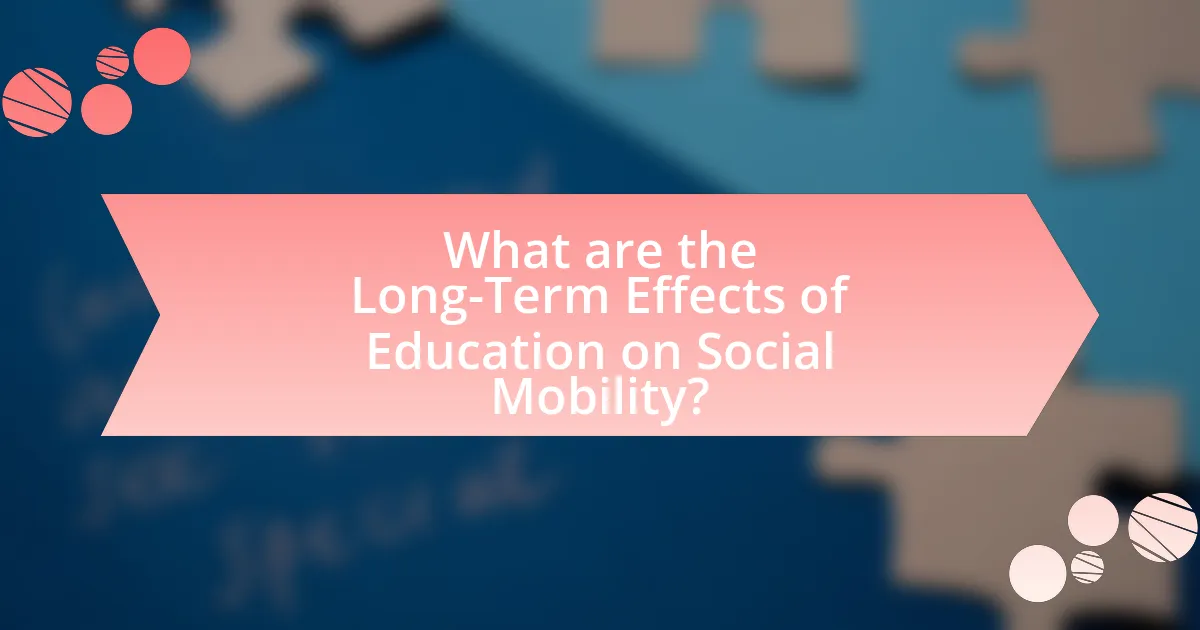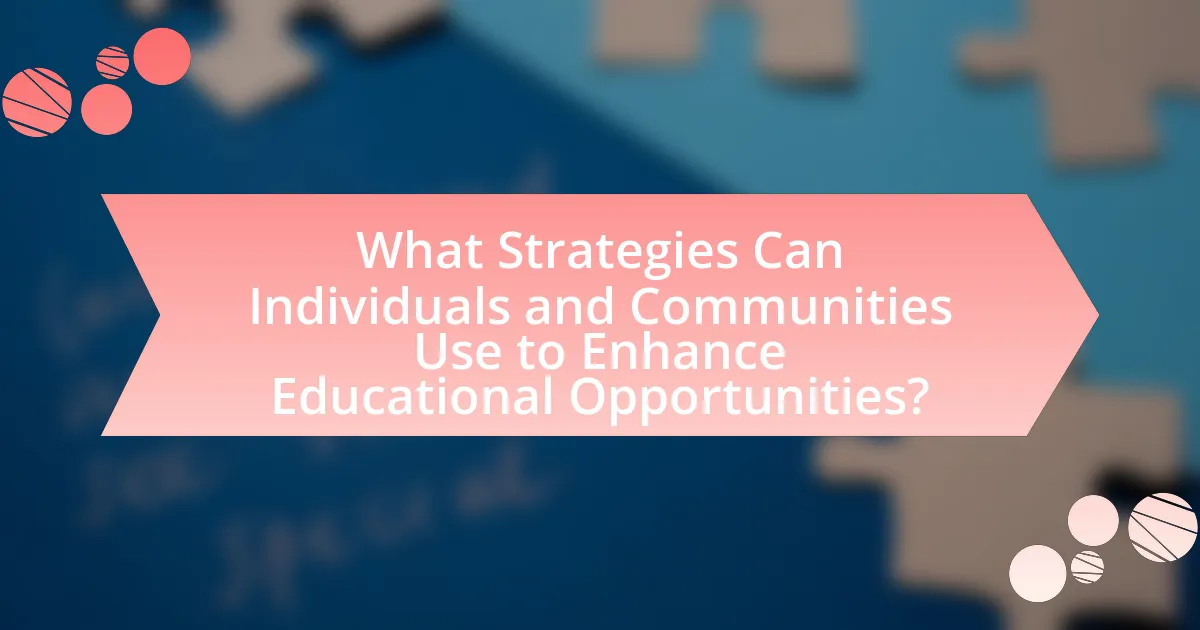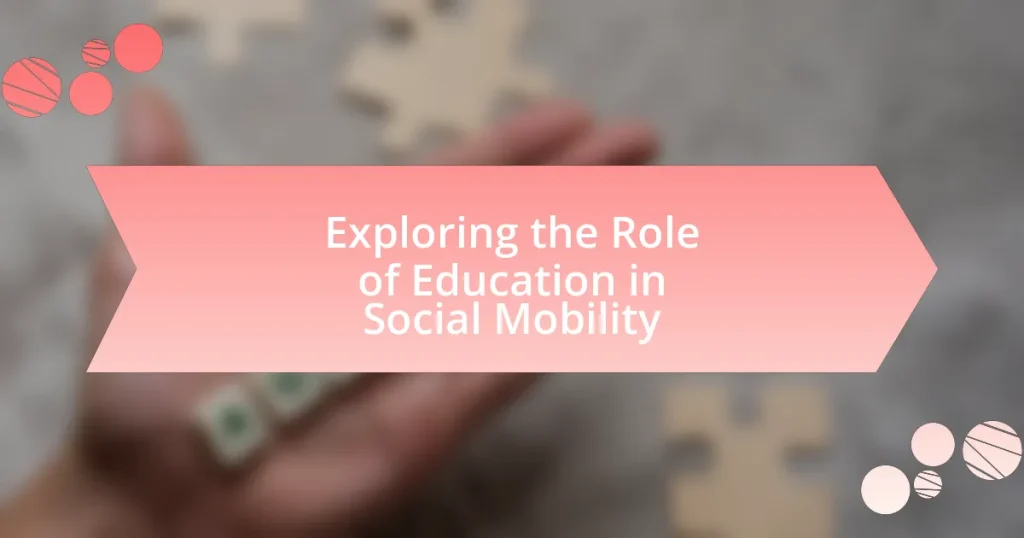The article explores the critical role of education in facilitating social mobility, emphasizing how access to quality education equips individuals with essential skills and knowledge to improve their economic status. It highlights the correlation between educational attainment and income levels, noting that individuals with higher education, such as bachelor’s degrees, earn significantly more than those with only high school diplomas. The article also addresses the disparities in educational access across different socioeconomic groups, the systemic barriers faced by disadvantaged populations, and the long-term effects of education on intergenerational mobility. Additionally, it discusses strategies for enhancing educational opportunities through community support, mentorship programs, and equitable funding policies, ultimately underscoring education as a vital pathway to upward mobility and economic growth.

What is the Role of Education in Social Mobility?
Education plays a crucial role in social mobility by providing individuals with the skills and knowledge necessary to improve their economic status. Access to quality education enhances job opportunities, increases earning potential, and fosters critical thinking, which are essential for upward mobility. Studies indicate that individuals with higher levels of education tend to earn significantly more over their lifetimes; for instance, the U.S. Bureau of Labor Statistics reports that individuals with a bachelor’s degree earn approximately 66% more than those with only a high school diploma. Furthermore, education can break the cycle of poverty by equipping disadvantaged groups with the tools needed to succeed in the labor market, thereby promoting a more equitable society.
How does education influence an individual’s social status?
Education significantly influences an individual’s social status by providing access to better job opportunities and higher income potential. Individuals with higher levels of education, such as college degrees, are more likely to secure employment in well-paying professions, which elevates their economic standing and social perception. For instance, data from the U.S. Bureau of Labor Statistics indicates that individuals with a bachelor’s degree earn approximately 66% more than those with only a high school diploma. This income disparity contributes to differences in lifestyle, social networks, and community involvement, further solidifying the link between education and social status.
What are the key factors that link education to social mobility?
Education significantly influences social mobility through factors such as access to quality education, skill development, and networking opportunities. Access to quality education ensures that individuals acquire the necessary knowledge and skills to compete in the job market, which is supported by research indicating that higher educational attainment correlates with increased income levels. Skill development, particularly in critical thinking and problem-solving, enhances employability and career advancement, as evidenced by studies showing that individuals with higher education levels tend to secure better job positions. Networking opportunities provided by educational institutions facilitate connections that can lead to job placements and career growth, reinforcing the link between education and upward social mobility.
How does access to education vary across different socioeconomic groups?
Access to education significantly varies across different socioeconomic groups, with individuals from lower-income backgrounds facing greater barriers to educational opportunities. Research indicates that children from low-income families are less likely to attend high-quality schools, often due to inadequate funding and resources in their communities. For instance, a report by the National Center for Education Statistics shows that students in high-poverty schools are more likely to experience larger class sizes, less experienced teachers, and fewer advanced placement courses compared to their peers in affluent areas. This disparity in access contributes to a cycle of poverty, limiting social mobility and perpetuating inequality.
Why is education considered a pathway to upward mobility?
Education is considered a pathway to upward mobility because it equips individuals with the skills and knowledge necessary to access better job opportunities and higher income levels. Research indicates that individuals with higher levels of education tend to earn significantly more over their lifetimes compared to those with lower educational attainment; for instance, the U.S. Bureau of Labor Statistics reports that in 2021, individuals with a bachelor’s degree earned approximately 67% more than those with only a high school diploma. This correlation between education and income facilitates economic advancement, allowing individuals to improve their social status and quality of life.
What evidence supports the connection between education and income levels?
Education significantly influences income levels, with numerous studies demonstrating a positive correlation. For instance, the U.S. Bureau of Labor Statistics reports that individuals with a bachelor’s degree earn approximately 65% more than those with only a high school diploma. Additionally, research by the Georgetown University Center on Education and the Workforce indicates that by 2020, 65% of all jobs in the economy will require postsecondary education, further emphasizing the link between higher education and increased earning potential. These statistics illustrate that higher educational attainment generally leads to higher income levels, reinforcing the connection between education and economic outcomes.
How do educational qualifications impact employment opportunities?
Educational qualifications significantly enhance employment opportunities by providing individuals with the necessary skills and knowledge that employers seek. Research indicates that higher educational attainment correlates with lower unemployment rates and higher earning potential. For instance, the U.S. Bureau of Labor Statistics reported in 2022 that individuals with a bachelor’s degree had an unemployment rate of 2.2%, compared to 6.7% for those with only a high school diploma. This data underscores the importance of educational qualifications in securing stable and well-paying jobs, thereby facilitating social mobility.
What challenges exist in leveraging education for social mobility?
The challenges in leveraging education for social mobility include systemic inequalities, access to quality education, and socio-economic barriers. Systemic inequalities manifest in the form of funding disparities among schools, which often correlate with the wealth of the surrounding community, leading to unequal educational resources. Access to quality education is further hindered by geographic location, where students in rural or low-income urban areas may have limited options for high-performing schools. Socio-economic barriers, such as the need for students to work part-time jobs to support their families, can detract from their academic performance and engagement. According to the National Center for Education Statistics, students from low-income families are less likely to graduate from high school and pursue higher education, highlighting the direct impact of these challenges on social mobility.
What barriers do disadvantaged groups face in accessing quality education?
Disadvantaged groups face multiple barriers in accessing quality education, including economic constraints, inadequate infrastructure, and systemic discrimination. Economic constraints limit access to resources such as textbooks, technology, and transportation, which are essential for effective learning. Inadequate infrastructure, particularly in low-income areas, often results in overcrowded classrooms and insufficient educational materials. Systemic discrimination, whether based on race, ethnicity, or socioeconomic status, can lead to lower expectations from educators and reduced opportunities for advancement. According to the National Center for Education Statistics, students from low-income families are less likely to graduate high school and pursue higher education, highlighting the impact of these barriers on educational outcomes.
How do systemic inequalities affect educational outcomes?
Systemic inequalities significantly hinder educational outcomes by creating disparities in access to resources, quality of instruction, and support systems. For instance, students from low-income backgrounds often attend underfunded schools that lack essential materials, experienced teachers, and advanced coursework opportunities. According to the National Center for Education Statistics, schools in high-poverty areas receive about $1,200 less per student than those in affluent areas, leading to lower academic performance and graduation rates. Furthermore, systemic barriers such as racial discrimination and socioeconomic status contribute to achievement gaps, as evidenced by the fact that Black and Hispanic students consistently score lower on standardized tests compared to their white peers. These inequalities perpetuate cycles of disadvantage, limiting social mobility and reinforcing existing societal stratifications.
How can education systems be improved to enhance social mobility?
Education systems can be improved to enhance social mobility by implementing equitable funding models that ensure all schools receive adequate resources regardless of their geographic location or socioeconomic status. Research indicates that schools in low-income areas often lack essential facilities and qualified teachers, which directly impacts student outcomes. For instance, a study by the National Center for Education Statistics shows that students in well-funded schools perform significantly better on standardized tests compared to those in underfunded institutions. Additionally, integrating vocational training and career counseling into the curriculum can provide students with practical skills and pathways to employment, further promoting upward mobility. Programs that focus on early childhood education have also been shown to yield long-term benefits, as children who receive quality early education are more likely to succeed academically and economically later in life.
What policies can promote equitable access to education?
Policies that can promote equitable access to education include universal pre-K programs, funding for low-income schools, and targeted scholarships for underrepresented groups. Universal pre-K programs ensure that all children, regardless of socioeconomic status, have access to early education, which is crucial for long-term academic success. Funding for low-income schools addresses disparities in resources, allowing these institutions to provide better facilities, qualified teachers, and essential learning materials. Targeted scholarships for underrepresented groups help to alleviate financial barriers, enabling students from diverse backgrounds to pursue higher education. Research indicates that equitable funding models can significantly improve educational outcomes for disadvantaged populations, as evidenced by studies showing that increased investment in low-income schools leads to higher graduation rates and improved student performance.
How can community programs support educational attainment for low-income families?
Community programs can support educational attainment for low-income families by providing access to resources, mentorship, and academic support. These programs often offer tutoring, after-school activities, and parental engagement initiatives that enhance learning opportunities. For instance, research from the National Center for Children in Poverty indicates that children from low-income families who participate in community-based educational programs show improved academic performance and higher graduation rates. Additionally, programs that facilitate access to technology and learning materials can bridge the resource gap, further promoting educational success among these families.

What are the Long-Term Effects of Education on Social Mobility?
Education significantly enhances social mobility by providing individuals with the skills and qualifications necessary for better employment opportunities. Research indicates that higher levels of education correlate with increased income potential and job stability, which in turn facilitates upward mobility across generations. For instance, a study by the Pew Research Center found that individuals with a bachelor’s degree earn approximately 66% more than those with only a high school diploma over their lifetime. Additionally, education can break cycles of poverty, as children from educated families are more likely to pursue higher education themselves, perpetuating a cycle of improved socioeconomic status.
How does education impact intergenerational mobility?
Education significantly enhances intergenerational mobility by providing individuals with the skills and knowledge necessary to access better job opportunities and higher income levels. Research indicates that higher educational attainment correlates with increased earnings; for instance, individuals with a bachelor’s degree earn approximately 66% more than those with only a high school diploma over their lifetime. This economic advantage allows families to invest more in their children’s education, creating a cycle that promotes upward mobility across generations. Furthermore, studies show that education reduces the likelihood of poverty, which is a critical factor in breaking the cycle of disadvantage that often persists across generations.
What role does parental education play in children’s educational success?
Parental education significantly influences children’s educational success. Research indicates that children of parents with higher educational attainment tend to perform better academically. For instance, a study published in the “Journal of Educational Psychology” found that parental education levels are strongly correlated with children’s academic achievement, with children of college-educated parents scoring higher on standardized tests and having better overall school performance. This correlation can be attributed to various factors, including the provision of a stimulating learning environment, access to educational resources, and the encouragement of academic aspirations.
How does educational attainment influence future generations’ opportunities?
Educational attainment significantly influences future generations’ opportunities by enhancing access to better employment, higher income potential, and improved social mobility. Individuals with higher education levels are more likely to secure jobs that offer greater financial stability and benefits, which in turn allows them to invest in their children’s education and well-being. Research indicates that children of college-educated parents are 50% more likely to attend college themselves, as highlighted in the National Center for Education Statistics report, which shows a direct correlation between parental education levels and children’s educational outcomes. This cycle of educational attainment fosters a more educated workforce, contributing to overall economic growth and social equity.
What are the economic implications of education on social mobility?
Education significantly enhances social mobility by providing individuals with the skills and knowledge necessary to access better job opportunities and higher income levels. Studies indicate that higher educational attainment correlates with increased earnings; for instance, individuals with a bachelor’s degree earn approximately 66% more than those with only a high school diploma over their lifetime. This wage premium facilitates upward mobility, allowing individuals from lower socioeconomic backgrounds to improve their economic status. Furthermore, education contributes to economic growth by fostering a more skilled workforce, which in turn attracts investment and creates jobs, thereby benefiting society as a whole.
How does a more educated workforce contribute to economic growth?
A more educated workforce contributes to economic growth by enhancing productivity and innovation. Higher education levels equip individuals with advanced skills and knowledge, leading to increased efficiency in various sectors. For instance, a study by the Organisation for Economic Co-operation and Development (OECD) found that a 1% increase in the share of the population with tertiary education can boost GDP by approximately 0.5%. Additionally, educated workers are more likely to engage in entrepreneurial activities, driving job creation and technological advancements. This correlation between education and economic performance underscores the critical role of a skilled workforce in fostering sustainable economic development.
What are the costs associated with educational inequality?
The costs associated with educational inequality include reduced economic productivity, increased social welfare expenditures, and diminished social cohesion. Educational inequality leads to a workforce that is less skilled, which in turn results in lower overall economic output; for instance, a study by the McKinsey Global Institute estimates that closing the educational achievement gap could add $1.3 trillion to the U.S. economy by 2030. Furthermore, individuals from disadvantaged educational backgrounds often rely more on social services, increasing government spending on welfare programs. Additionally, educational disparities contribute to social fragmentation, as unequal access to quality education fosters divisions within communities, undermining social trust and cohesion.
How does education shape social networks and capital?
Education shapes social networks and capital by providing individuals with access to diverse social connections and resources. Higher levels of education often lead to increased opportunities for networking, as educational institutions serve as platforms for interaction among peers, faculty, and industry professionals. For instance, research by Granovetter (1973) in “The Strength of Weak Ties” demonstrates that weak ties, often formed through educational settings, can be crucial for accessing job opportunities and information not available within close-knit groups. Additionally, educational attainment correlates with social capital, as individuals with higher education levels typically engage in more civic activities and community involvement, further expanding their social networks. This relationship is supported by findings from the Pew Research Center, which indicate that college graduates are more likely to participate in social organizations and volunteer activities, thereby enhancing their social capital.
What is the relationship between education and social capital?
Education significantly enhances social capital by fostering networks, trust, and shared norms among individuals. Higher levels of education often lead to increased social interactions and community engagement, which are essential components of social capital. Research indicates that educated individuals are more likely to participate in civic activities, volunteerism, and social organizations, thereby strengthening community ties. For instance, a study by Putnam (2000) in “Bowling Alone” highlights that educational attainment correlates with greater social engagement and trust within communities, demonstrating that education serves as a catalyst for building social capital.
How do educational institutions foster connections that aid mobility?
Educational institutions foster connections that aid mobility by creating networks among students, alumni, and industry professionals. These networks provide access to mentorship, internships, and job opportunities, which are crucial for career advancement. For instance, universities often host career fairs and networking events that connect students with potential employers, facilitating entry into the job market. Research indicates that students who engage in networking activities are more likely to secure employment after graduation, highlighting the effectiveness of these connections in enhancing social mobility.

What Strategies Can Individuals and Communities Use to Enhance Educational Opportunities?
Individuals and communities can enhance educational opportunities through targeted initiatives such as mentorship programs, community partnerships, and resource allocation. Mentorship programs connect students with experienced professionals, providing guidance and support that can improve academic performance and career readiness. For instance, studies show that students with mentors are 55% more likely to enroll in college and 78% more likely to volunteer regularly. Community partnerships with local businesses and organizations can create internships and job shadowing opportunities, allowing students to gain practical experience and exposure to various career paths. Additionally, allocating resources such as funding for after-school programs and scholarships can directly impact students’ access to quality education. Research indicates that increased funding for education correlates with improved student outcomes, highlighting the importance of financial support in enhancing educational opportunities.
What role do mentorship and support systems play in education?
Mentorship and support systems play a crucial role in education by enhancing student engagement, academic performance, and personal development. These systems provide guidance, resources, and emotional support, which are essential for navigating educational challenges. Research indicates that students with mentors are more likely to pursue higher education and achieve better academic outcomes. For instance, a study by the National Mentoring Partnership found that mentored students are 55% more likely to enroll in college and 78% more likely to volunteer regularly in their communities. This evidence underscores the significant impact of mentorship and support systems on educational success and social mobility.
How can mentorship programs improve educational outcomes for at-risk youth?
Mentorship programs can significantly improve educational outcomes for at-risk youth by providing personalized guidance, support, and resources that enhance academic performance and engagement. These programs often connect youth with mentors who can offer tailored advice, encouragement, and accountability, which are crucial for overcoming barriers to education. Research indicates that students with mentors are 55% more likely to enroll in college and 78% more likely to volunteer regularly in their communities, demonstrating the positive impact of mentorship on educational aspirations and civic involvement. Additionally, a study by the National Mentoring Partnership found that mentored youth show improved school attendance and higher grades, underscoring the effectiveness of mentorship in fostering a supportive learning environment.
What community resources are available to support educational advancement?
Community resources available to support educational advancement include public libraries, community colleges, tutoring programs, and non-profit organizations focused on education. Public libraries provide access to a wealth of educational materials and often host free workshops and classes. Community colleges offer affordable higher education options and vocational training, which can enhance job prospects. Tutoring programs, often run by local schools or community centers, provide personalized academic support to students. Non-profit organizations, such as Big Brothers Big Sisters and local educational foundations, often provide mentorship and scholarships to help students pursue their educational goals. These resources collectively contribute to improving educational outcomes and fostering social mobility within communities.
What best practices can be implemented to maximize educational impact?
To maximize educational impact, implementing evidence-based teaching strategies is essential. These strategies include differentiated instruction, which tailors learning experiences to meet individual student needs, and formative assessment, which provides ongoing feedback to improve student learning. Research shows that differentiated instruction can lead to higher student engagement and achievement, as highlighted in Tomlinson’s work on differentiated classrooms. Additionally, formative assessments have been proven to enhance learning outcomes by allowing educators to adjust their teaching methods based on student performance, as demonstrated in studies by Black and Wiliam. By focusing on these best practices, educational systems can significantly improve student success and promote social mobility.
How can families effectively advocate for their children’s education?
Families can effectively advocate for their children’s education by actively engaging with teachers and school administrators to communicate their children’s needs and aspirations. This engagement includes attending parent-teacher conferences, participating in school board meetings, and joining parent-teacher associations, which provide platforms for families to voice concerns and influence educational policies. Research indicates that parental involvement is linked to improved student performance; for instance, a study by the National Center for Education Statistics found that students whose parents are involved in their education are more likely to achieve higher grades and test scores. By fostering open communication and collaboration with educational stakeholders, families can ensure that their children’s educational experiences are tailored to support their academic and social development.
What strategies can schools adopt to engage parents and communities?
Schools can adopt strategies such as establishing regular communication channels, organizing community events, and creating parent advisory committees to engage parents and communities effectively. Regular communication through newsletters, emails, and social media keeps parents informed about school activities and encourages their involvement. Organizing community events, such as open houses and workshops, fosters relationships between families and educators, enhancing community ties. Additionally, forming parent advisory committees allows parents to have a voice in school decision-making, promoting collaboration and investment in the educational process. Research indicates that schools with strong family and community engagement see improved student outcomes, highlighting the importance of these strategies in fostering social mobility.
What are the key takeaways for promoting education as a tool for social mobility?
Promoting education as a tool for social mobility requires targeted investment in accessible and quality education systems. Research indicates that individuals with higher education levels tend to earn significantly more over their lifetimes; for instance, a bachelor’s degree holder earns approximately 66% more than a high school graduate, according to the U.S. Bureau of Labor Statistics. Additionally, initiatives that focus on early childhood education have shown to yield long-term benefits, as children from disadvantaged backgrounds who participate in quality early education programs are more likely to succeed academically and economically. Furthermore, fostering partnerships between educational institutions and local businesses can enhance job readiness and create pathways for employment, thereby directly linking education to economic opportunities.
